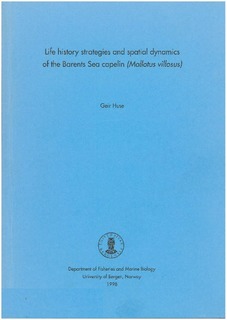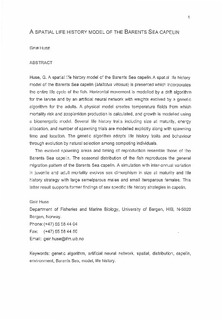| dc.description.abstract | This thesis consists of four papers on the life history strategy and spatial distribution of the Barents Sea capelin (Mallotus villosus). In the first two papers, sex specific aspects of capelin life history are investigated from a combination of field sampling and modelling. Paper III deals with the development of a concept for modelling spatial distribution of fish, and in Paper IV the concept is applied for the Barents Sea capelin.
Female capelin were found to invest much more energy into reproductive tissue than males. Capelin fecundity was found to depend upon body weight, and inter annual variation in fecundity is related to variation in body weight. A life history model (Paper II) predicts that males have a higher fitness associated with semelparity than females since males may fertilise many females, whereas female fitness is limited by her number of eggs. Given a high or variable adult mortality risk, it may be more profitable for males to be semelparous than iteroparous. Capelin is therefore predicted to have sex specific life history strategies with semelparous males and iteroparous females. This prediction is supported by literature on capelin ecology.
In Paper III a concept for modelling spatial distribution of fish is developed. The background for applying a new approach to studying fish distribution, is the lack of approaches for solving specific problems related to capelin ecology. The model is individual based and behaviour is calculated using an artificial neural network where weights are evolved using a genetic algorithm. Through simulating evolution by natural selection in a seasonal spatial model with life cycle, physiology, mortality, and reproduction, the individuals with the best "genetic weights" become increasingly more common in the population. Eventually the population consists of well-adapted individuals, which migrate back to spawning areas in winter, and grow and avoid being eaten throughout the rest of the year. The importance of separating between reactive and predictive behaviour in controlling local search and long distance migration respectively, is discussed. In Paper IV this model is elaborated to include: explicit representation of each stage in the life cycle of the Barents Sea capelin, larval drift, and evolution of spawning areas and timing of reproduction. Furthermore the model includes life history traits such as size at maturity, allocation of energy, and number of reproductive events. Larval drift was associated with a warm water area, and the evolved spawning ground was situated upstream from this, in the outskirts of the range for capelin spawning. The migration pattern follows the same general pattern as that of the Barents Sea capelin. In a simulation with stochastic mortality rates, sex specific life history strategies with semelparous males and iteroparous females were evolved, which supports the predictions from Paper II.
The major achievement of this study is the development of an evolutionary system for fish migration, and the way this is applied to provide predictions about the life history and spatial dynamics of the Barents Sea capelin. Another important finding is the recognition that some aspects of capelin life history strategy are sex specific, with female iteroparity and male semelparity. | nb_NO |

